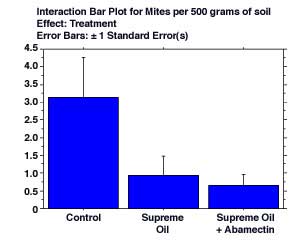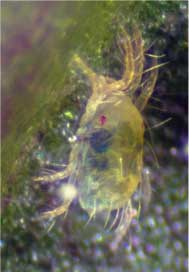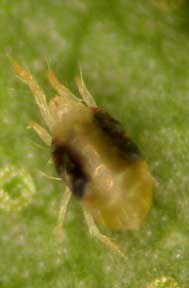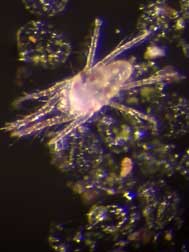Twospotted Spider Mite in Mint
Twospotted spider mite, Tetranychus urticae, causes damage to mint plants through its feeding action. The mite sucks the juices out of mint plants, causing leaves to yellow, bronze, dry, and fall under heavy infestations. Spider mite infestations are known reduce mint oil yield and probably quality.
2011 Miticide Efficacy Studies
On 28 July 2011 the following treatments were applied to an uncut peppermint field in 35 gpa. Mite population assessments were taken by counting the number of mites observed on 30 leaves following 7, 14, and 21 days after treatment. Although mite populations were low, all of the candidate products tested controlled spider mites.
| Mites per 30 leaves ± Standard Error | ||||
| Product | Rate per acre | 8/3/11 | 8/10/11 | 8/17/11 |
| Acramite 50WP | 1.5 #/acre | 1.00±0.71** | 0** | 0** |
| BAS 92100I (Nealta) | 27.4 fl oz | 0.75±0.25** | 2.25±2.25** | 0** |
| Oberon + NIS | 16 oz | 0** | 0** | 0** |
| Zeal 72 WP + NIS | 3 oz | 1.75±1.00** | 0.50±0.50** | 0** |
| Zeal 72 WP + NIS | 4 oz | 0.75±0.75** | 0.50±0.50** | 0** |
| Untreated | n/a | 16.75±5.39 | 17.25±5.90 | 4.00±1.58 |
| **/ mite population is significantly (p<0.01) lower then in untreated control in pair wise t-tests | ||||
As an additional component of integrated mite management, we are initiating a study in the fall of 2011 to assess the toxicity of various miticides on the western predatory mite.
2010-2011 Dormant Season Efficacy Trials
In fall 2010 we purchased a portable “chemigator” to mimic pesticide applications that would be applied by center pivot irrigation. On 23 March 2011 we applied 2 candidate treatments to our test peppermint field at WSU's Irrigated Agriculture Research and Extension Center in Prosser, Washingnton. The treatments were applied to 3 replicates and were Supreme oil at 0.5% by volume, abamectin at 0.018 lb ai/ acre (1 pint Agrimeck) plus Supreme oil at 0.5% by volume, and an untreated control applied in 1/8 inch of water. 
On 12 April, 500-gram soil cores were collected at a frequency of 5 per replicate plot. These soil cores were placed in our bank of research Berlese funnels and heated for 24 hours by incandescent light bulbs. The arthropods that dropped out of these heated samples were captured in a 50% alcohol solution, then sorted and quantified under a dissecting microscope. The two treatments of oil (with and without abamectin) significantly (p<0.05) reduced the number of mites emerging from the soil cores in the 500 gram samples.
On May 12 we collected 10 shoots per replicate and evaluated them under the dissecting microscope for mite abundance. No spider mites were detected on these shoots.
On 23 May, 3 and 22 June, and 13 July thirty leaves were collected from each replicate plot and analyzed under a dissecting microscope. From the 270 leaves scanned on each respective sample date a total of 4 mites were observed on 23 May, no mites were detected on 2 June, 36 mites were detected on 22 June, and 62 mites were detected on 22 July. Our results regarding mites on leaves were inconclusive.
Entomology subpage
This page is designed to provide additional information pursuant to the Entomology component of the overall project discussed on the Washington State University website http://hopmintstress.wsu.edu .
It is not designed to be viewed or utilized independently of that website.
Return to Entomology page.
Return to home page.
TSSM Images

Twospotted spider mite, Tetranychus urticae

Adult female (note prominent black spots on each side of abdomen); adults are approximately 1/50-inch long

Adult male; males are approximately 3/4 the size of females and have a more pointed abdomen

Adult, nymphs, and eggs; eggs are clear to pearly-white spheres approximately 1/200-inch in diameter